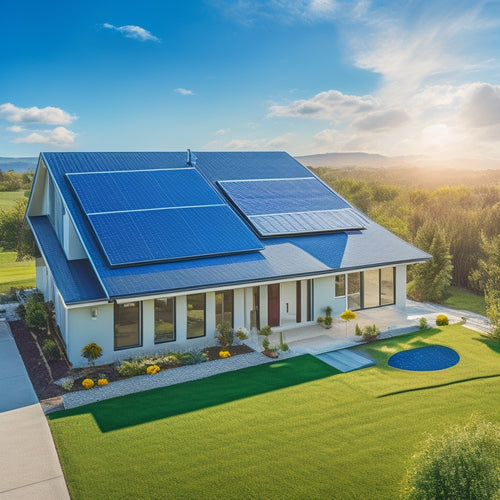
Boosting Motorcycle Speed With Proven Performance Tips
Share
You can unleash significant speed gains by focusing on key areas of motorcycle optimization. Start by maximizing your electric motor's potential, evaluating its winding configuration for efficiency, and upgrading to high-temperature magnet wire. Next, consider advanced battery management systems, aerodynamic improvements, and regenerative braking techniques to boost power and reduce drag. Fine-tune your gear ratios, throttle response calibration, and cooling system for peak performance. Finally, select high-performance tires designed for speed and grip. By applying these proven tips, you'll be well on your way to realizing your motorcycle's full speed potential - and that's just the beginning.
Key Takeaways
• Optimize electric motor settings, winding configuration, and wire selection to maximize power and efficiency.
• Upgrade battery management system with advanced monitoring, charging, and voltage stabilization for improved performance.
• Improve aerodynamics by analyzing airflow, optimizing bike shape, and selecting wheels and tires that reduce drag.
• Harness kinetic energy with regenerative braking techniques to improve acceleration and reduce brake pad wear.
• Fine-tune gear ratios, throttle response, and fuel injection timing to unleash the bike's full potential and achieve optimal performance.
Optimizing Electric Motor Output
By optimizing your electric motor's settings, you can maximize its full potential and achieve a significant boost in power and torque. To get started, take a closer look at your motor winding configuration. A well-designed motor winding can greatly impact your motor's efficiency and performance.
Consider upgrading to a high-temperature magnet wire, which can withstand the heat generated by high-performance riding. Additionally, selecting the right copper selection is essential. Look for copper with high conductivity and low resistance to minimize energy losses. A good rule of thumb is to opt for copper with a higher strand count, as it provides better flexibility and durability.
By making these adjustments, you can increase your motor's power density, allowing it to produce more power and torque. With these tweaks, you'll be able to feel the difference on the road, accelerating faster and smoother than ever before.
Battery Management System Upgrades
When upgrading your motorcycle's battery management system, you'll want to focus on three key areas to enhance performance.
You'll need to implement advanced battery monitoring to keep tabs on your battery's state of charge, voltage, and temperature. By doing so, you'll be able to optimize charging efficiency and enhance power delivery, ultimately giving your bike a much-needed speed boost.
Advanced Battery Monitoring
You can greatly enhance your motorcycle's electrical system by installing a state-of-the-art battery management system that provides advanced monitoring capabilities.
This upgrade will give you a better understanding of your bike's battery health, allowing you to identify potential issues before they become major problems.
With advanced monitoring, you'll be able to track your battery's voltage and state of charge in real-time, ensuring you're always aware of your bike's electrical system's performance.
Improved Charging Efficiency
Upgrading your battery management system with advanced charging algorithms can greatly enhance your motorcycle's charging efficiency, allowing you to maximize the potential of your electrical system. By optimizing your charging system, you can guarantee that your battery is always fully charged and ready to provide the power you need to elevate your ride to the next level.
Here are four ways to improve your motorcycle's charging efficiency:
-
Alternator upgrade: Installing a high-performance alternator can notably increase your motorcycle's charging capacity, ensuring that your battery is always fully charged.
-
Voltage stabilization: Implementing a voltage stabilization system can help regulate your motorcycle's electrical output, reducing power fluctuations and ensuring a smooth ride.
-
Smart charging algorithms: Advanced charging algorithms can optimize your motorcycle's charging system, ensuring that your battery is charged quickly and efficiently.
- Battery monitoring: Installing a battery monitoring system can help you keep track of your motorcycle's battery health, allowing you to identify and address any issues before they become major problems.
Enhanced Power Delivery
By integrating advanced battery management system upgrades, your motorcycle can experience a significant boost in power delivery, allowing you to tap into its full potential. This is achieved by optimizing the flow of electrical energy to your bike's engine, ensuring that it receives the power it needs to perform at its best.
With advanced battery management, you'll notice improvements in fuel injection and engine tuning. Your motorcycle's engine will run more efficiently, and you'll experience increased power and responsiveness. This is especially important for riders who crave the thrill of high-speed riding or those who need an extra burst of power to navigate challenging terrain.
Upgrading your battery management system is a straightforward process that can be done in a few hours. You'll need to install a high-performance battery, an advanced charger, and a sophisticated monitoring system.
With these upgrades, you'll be able to track your motorcycle's power delivery in real-time, making adjustments as needed to optimize performance. By taking your battery management to the next level, you'll maximize your motorcycle's full potential and experience the rush of riding a finely-tuned machine.
Reducing Aerodynamic Drag Coefficients
Aerodynamic drag coefficients can be markedly reduced on your motorcycle by optimizing its frontal area, smoothing airflow, and minimizing turbulence. This can be achieved through a combination of design tweaks and clever modifications.
Here are some ways to get you started:
-
Airflow Analysis: Use computational fluid dynamics (CFD) or wind tunnel testing to identify areas of high drag and optimize your bike's shape accordingly.
-
Streamlined Fairings: Replace stock fairings with sleek, aerodynamically designed ones that reduce turbulence and drag.
-
Rear Section Refinement: Optimize the rear section of your bike to reduce drag by minimizing the size of the tail section and smoothing out the airflow.
- Wheel and Tire Optimization: Select wheels and tires that are designed to reduce drag, such as those with a narrow profile and a smooth, rounded shape.
Regenerative Braking Techniques
As you squeeze the brake lever, regenerative braking techniques can harness kinetic energy and convert it into electrical energy, potentially enhancing your motorcycle's overall performance and fuel efficiency. This innovative technology takes advantage of the kinetic energy generated by your bike's motion, capturing it and converting it into electrical energy that can be reused.
By doing so, you'll not only improve your motorcycle's acceleration but also reduce wear on your brake pads, extending their lifespan.
To optimize regenerative braking, mastering the art of smooth braking is vital. Avoid sudden, abrupt stops, as they can disrupt the kinetic energy conversion process. Instead, use gentle, gradual braking to maximize energy capture.
Additionally, maintaining your brake pads in good condition is important, as worn-out pads can compromise the regenerative braking system's effectiveness. By combining regenerative braking techniques with proper brake pad maintenance, you'll unleash your motorcycle's full potential, achieving enhanced performance and fuel efficiency.
Efficient Gear Ratio Tuning
Your motorcycle's gear ratio tuning can greatly impact its acceleration, top speed, and overall performance, making it a crucial component to optimize alongside regenerative braking techniques. By fine-tuning your gearbox, you can reveal hidden power and enhance your bike's overall responsiveness.
Here are some key areas to focus on for efficient gear ratio tuning:
-
Ratio optimization: Experiment with different gear ratios to find the sweet spot that balances acceleration and top speed.
-
Gearbox refurbishment: Regularly inspect and maintain your gearbox to guarantee smooth shifting and peak performance.
-
Torque management: Adjust your gear ratios to control torque output and prevent wheel spin or loss of traction.
- RPM optimization: Fine-tune your gear ratios to keep your engine within its power band, maximizing horsepower and torque output.
Advanced Throttle Response Calibration
As you fine-tune your motorcycle's performance, you'll want to focus on advanced throttle response calibration to unleash its full potential.
By optimizing throttle mapping strategies and calibration best practices, you'll be able to achieve a more responsive and efficient ride.
Throttle Mapping Strategies
By fine-tuning your throttle mapping strategy, you can access significant performance gains, particularly in low-to-mid RPM ranges where most street riding occurs. This is especially important since most motorcycles spend a majority of their time in these RPM ranges.
To optimize your throttle mapping, consider the following strategies:
-
Fuel Injection Tuning: Adjust fuel injection timing to guarantee ideal air-fuel mixtures, resulting in increased power and efficiency.
-
Ignition Timing Optimization: Fine-tune ignition timing to take full advantage of the best combustion point, leading to increased horsepower and torque.
-
Throttle Response Calibration: Calibrate throttle response to eliminate lag and hesitation, allowing for smoother acceleration and improved rideability.
- Closed-Loop Fuel Injection: Implement closed-loop fuel injection to continuously monitor and adjust air-fuel mixtures, ensuring peak performance and efficiency.
Calibration Best Practices
To achieve peak throttle response calibration, you'll want to follow a structured approach, methodically adjusting parameters to minimize lag and hesitation. This means diving into the nuances of advanced throttle response calibration, where every millisecond counts.
Spark Timing, for instance, plays a critical role in optimizing engine performance. By fine-tuning spark timing, you can reduce engine knock and pinging, ensuring a smoother, more responsive ride.
Next, focus on Fuel Mapping, which involves adjusting the air-fuel mixture to match your bike's specific needs. This might involve enriching or leaning out the mixture, depending on factors like throttle position, engine speed, and load.
By meticulously calibrating these parameters, you'll maximize your motorcycle's full potential, delivering a more agile, responsive ride that leaves the competition in the dust.
Cooling System Performance Enhancements
Regularly inspecting and maintaining your motorcycle's cooling system can greatly enhance its performance and overall efficiency. A well-maintained cooling system guarantees your engine runs at the best temperature, which translates to better power output and improved fuel efficiency.
Here are some key areas to focus on for cooling system performance enhancements:
-
Radiator Upgrades: Consider upgrading to a high-performance radiator with improved heat dissipation capabilities. This can notably reduce engine temperatures, especially during high-stress riding conditions.
-
Fan Clutch: Upgrade to a high-performance fan clutch that can effectively cool your engine, even in slow-moving traffic or stop-and-go conditions.
-
Coolant System Flush: Regularly flush your coolant system to remove debris and contaminants that can diminish cooling efficiency.
- Thermostat Upgrade: Consider upgrading to a high-performance thermostat that can optimize engine temperature, allowing for better performance and efficiency.
High-Performance Tire Selection
When you've optimized your motorcycle's cooling system, it's time to focus on the only contact point between your bike and the road: high-performance tires. You need tires that can handle the increased power and speed you're aiming for. The right tires will improve your bike's acceleration, braking, and cornering capabilities.
When selecting high-performance tires, consider the tire compound and tread pattern. A softer tire compound will provide better grip, but may wear out faster. A harder compound will last longer, but may compromise on grip. The tread pattern is also essential, as it affects traction, handling, and stability. Look for tires with a unique tread pattern that provides improved grip and water dispersal.
For high-performance riding, consider tires with a specialized compound that provides a balance between grip and durability. Additionally, look for tires with a tread pattern that's designed for high-speed cornering and braking. By choosing the right high-performance tires, you'll be able to take your motorcycle's speed to the next level.
Frequently Asked Questions
How Often Should I Clean My Motorcycle's Air Filter for Optimal Performance?
You should clean your motorcycle's air filter every 1,000 to 3,000 miles, depending on riding conditions, to prevent airflow restriction, ensuring peak performance and fuel efficiency; regular filter maintenance is key to unbridled power.
Can I Upgrade My Motorcycle's Engine Management System on My Own?
You can upgrade your motorcycle's engine management system on your own, but be cautious when reprogramming the ECU Reflash and rewiring the Wiring Harness, as one misstep can lead to costly repairs or even engine damage.
What Is the Ideal Tire Pressure for High-Speed Cornering?
When cornering at high speeds, you'll want to optimize your tire pressure, just like MotoGP rider Valentino Rossi, who ran 1.9 bar (27.5 psi) on his Ducati's soft-compound tires, emphasizing cornering technique and the right tire compound for maximum grip.
How Do I Troubleshoot and Fix Common Electrical System Faults?
"When troubleshooting electrical system faults, you'll first need to retrieve the Fault Code using a scan tool, then inspect wiring for signs of wear, corrosion, or damage, addressing any Wiring Issues you find to get your bike running smoothly again."
Can I Use Racing Fuel in My Street-Legal Motorcycle?
'Don't worry, you're not stuck with mediocre performance! You're wondering if racing fuel is compatible with your street-legal motorcycle's engine. Refer to your owner's manual to confirm compatibility with high-octane fuel types, as some engines aren't designed to handle them.'
Related Posts
-

What's the Best Green Ride for College Budgets?
As a college student on a budget, you're likely looking for an eco-friendly ride that won't break the bank. You've go...
-

5 Best Steps to Installing Solar Panels at Home
You're about to start on a journey to harness the power of solar energy at home. First, assess your home's solar pote...
-

7 Best Financial Incentives for Residential Homeowners
You're entitled to a range of financial incentives that can help offset the costs of owning a home, from federal tax ...


